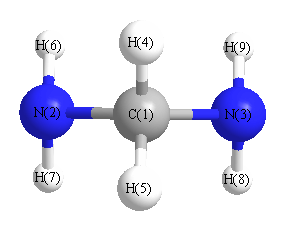Vibrational Frequencies calculated at CCSD(T)=FULL/aug-cc-pVTZ
| Mode Number |
Symmetry |
Frequency
(cm-1) |
Scaled Frequency
(cm-1) |
IR Intensities
(km mol-1) |
Raman Act
(Å4/u) |
Dep P |
Dep U |
|---|
| 1 |
A1 |
3505 |
3378 |
|
|
|
|
| 2 |
A1 |
3080 |
2968 |
|
|
|
|
| 3 |
A1 |
1670 |
1609 |
|
|
|
|
| 4 |
A1 |
1510 |
1456 |
|
|
|
|
| 5 |
A1 |
1106 |
1066 |
|
|
|
|
| 6 |
A1 |
865 |
833 |
|
|
|
|
| 7 |
A1 |
456 |
439 |
|
|
|
|
| 8 |
A2 |
3578 |
3449 |
|
|
|
|
| 9 |
A2 |
1410 |
1358 |
|
|
|
|
| 10 |
A2 |
1076 |
1037 |
|
|
|
|
| 11 |
A2 |
243 |
234 |
|
|
|
|
| 12 |
B1 |
3576 |
3447 |
|
|
|
|
| 13 |
B1 |
3106 |
2993 |
|
|
|
|
| 14 |
B1 |
1381 |
1331 |
|
|
|
|
| 15 |
B1 |
851 |
821 |
|
|
|
|
| 16 |
B1 |
364 |
351 |
|
|
|
|
| 17 |
B2 |
3504 |
3377 |
|
|
|
|
| 18 |
B2 |
1658 |
1598 |
|
|
|
|
| 19 |
B2 |
1396 |
1346 |
|
|
|
|
| 20 |
B2 |
1100 |
1060 |
|
|
|
|
| 21 |
B2 |
803 |
774 |
|
|
|
|
Unscaled Zero Point Vibrational Energy (zpe) 18119.3 cm
-1
Scaled (by 0.9637) Zero Point Vibrational Energy (zpe) 17461.5 cm
-1
See section
III.C.1 List or set vibrational scaling factors
to change the scale factors used here.
See section
III.C.2
Calculate a vibrational scaling factor for a given set of molecules
to determine the least squares best scaling factor.
